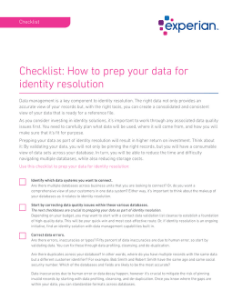- Products

Enjoy a free 30-day trial of our
data validation software.Experience the power of trusted data
solutions today, no credit card required! - Solutions

Enjoy a free 30-day trial of our
data validation software.Experience the power of trusted data
solutions today, no credit card required! - Partners

Enjoy a free 30-day trial of our
data validation software.Experience the power of trusted data
solutions today, no credit card required! - Learn more
- Pricing
- Contact Us
Checklist: How to prep your data for identity resolution
Data management is a key component to identity resolution. The right data not only provides an accurate view of your records but, with the right tools, you can create a consolidated and consistent view of your data that is ready for a reference file.
Data management maximizes your identity strategy. We’re here to help you ensure that you have trustworthy data to help enhance your identity solution and reap the benefits like better understanding your customers, navigating across databases easier, improving marketing ROI, and way more.
Use this checklist to prep your data as part of identity resolution. Once complete, we’re sure you will see a higher return on investment.
Data management is a key component to identity resolution. The right data not only provides an accurate view of your records but, with the right tools, you can create a consolidated and consistent view of your data that is ready for a reference file.
As you consider investing in identity solutions, it’s important to work through any associated data quality issues first. You need to carefully plan what data will be used, where it will come from, and how you will make sure that it’s fit for purpose.
Prepping your data as part of identity resolution will result in higher return on investment. Think about it: By validating your data, you will not only be pinning the right records, but you will have a consumable view of data sets across your database. In turn, you will be able to reduce the time and difficulty navigating multiple databases, while also reducing storage costs.
Use this checklist to prep your data for identity resolution:
- Identify which data systems you want to connect.
Are there multiple databases across business units that you are looking to connect? Or, do you want a comprehensive view of your customers in one data system? Either way, it’s important to think about the makeup of your databases as it relates to identity resolution. - Start by correcting data quality issues within these various databases.
The next checkboxes are crucial to prepping your data as part of identity resolution.
Depending on your budget, you may want to start with a contact data validation list cleanse to establish a foundation of high-quality data. This will be your quick-win and most cost-effective route. Or, if identity resolution is an ongoing initiative, find an identity solution with data management capabilities built in. - Correct data errors.
Are there errors, inaccuracies or typos? Fifty percent of data inaccuracies are due to human error, so start by validating data. You can fix these through data profiling, cleansing, and de-duplication.
Are there duplicates across your database? In other words, where do you have multiple records with the same data but a different customer identifier? For example, Bob Smith and Robert Smith have the same age and same social security number. Which of the databases and fields are likely to be the most accurate?
Data inaccuracies due to human error or data decay happen, however it’s crucial to mitigate the risk of pinning invalid records by starting with data profiling, cleansing, and de-duplication. Once you know where the gaps are within your data, you can standardize formats across databases. - Standardize your data.
Are there multiple databases across business units that you are looking to connect? Or, do you want a comprehensive view of your customers in one data system? Either way, it’s important to think about the makeup of your databases as it relates to identity resolution. - Add a reference file for identity resolution.
The above checkboxes provide you a foundation of data quality, which enables your identity resolution initiative. Now, if you wish, you have the right information for a reference file.
However, it’s possible this step could be optional, depending on the needs for your business and budget. Yes, a reference file allows you to say, with 100% certainty, that person is who they say they are, but with a valid and holistic view of your customer data, you can get pretty close to that without a reference file.
There are many benefits to having data management as part of identity resolution—better understand your customers, navigate across databases easier, improve marketing ROI, and way more. Data management maximizes your identity strategy.
Your next step: Find the right tech. Experian can help you integrate data management practices as part of your identity strategy. With a powerful data quality management and enrichment software, we have what you need to prep your data as part of identity resolution.
